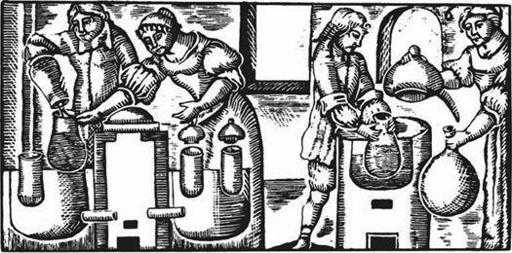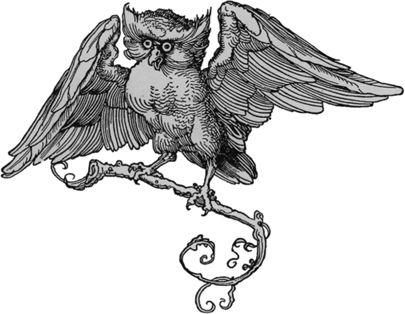Read The Sorcerer's Companion: A Guide to the Magical World of Harry Potter Online
Authors: Allan Zola Kronzek,Elizabeth Kronzek
The Sorcerer's Companion: A Guide to the Magical World of Harry Potter (57 page)
As a young man, however, Flamel seemed to have no particular interest in alchemy, although he had no doubt heard of it. He was well educated for a man of his era, literate in both Latin and French, and when it was time to set off on his own, he moved to Paris and went into business as a professional copyist, notary, and book dealer. Many of Flamel’s contemporaries could neither read nor write, and when they needed some important transaction recorded, they went to a professional scribe. Flamel also copied books and manuscripts (the printing press would not be invented for another hundred years), and earned additional income by giving writing lessons to the wealthy, teaching them, among other things, how to sign their names. His first shop was located in a tiny wood stall on the Street of Notaries, but as his successful business grew he hired a staff of apprentices, bought a nearby house, and relocated his store to the first floor. He also met and married Perenelle, an attractive and wealthy widow.
Until this point the young scribe’s life was ordinary enough. But all that changed when a stranger appeared in his shop and sold him a book that would change his life forever. “There fell into my hands,” he wrote, “for the sum of two florins, a gilded book, very old and large. It was not of paper or parchment as other books are, but made only of thin bark. The cover was of copper, very delicate, and engraved all over with strange figures.” Flamel studied the book and became convinced it contained the secret of making the Sorcerer’s Stone—if only he could understand it. But like all alchemical books, much of it was written in a deliberately cryptic language. And the deepest secrets of all were contained not in words but in mysterious symbolic pictures. One drawing, for example, showed a painted desert filled with beautiful fountains overflowing with serpents. Another depicted a windblown bush atop a mountain surrounded by
griffins
and
dragons
.
Flamel copied the drawings (no one but Perenelle was ever allowed to see the actual book), showed them to his colleagues and hung them in his shop, hoping someone could explain what they meant. But no one could. It was possibly at this point that Nicholas set up an alchemical laboratory and began experimenting, basing his procedures on those parts of the book that he did understand. But nothing worked. The alchemical tradition required that those who would learn “the art” must first be initiated into its secrets by a master. And so, after many failed experiments, Flamel finally sought out and found such a teacher living in Spain. With the
real
secrets of the book at last at hand Flamel returned to Paris where, after three years of intensive labor, he achieved his goal. “I made projection of the red Stone upon a quantity of mercury,” he wrote, “in the presence of Perenelle only, which I transmuted truly into almost as much pure gold.”

Alchemical processes often took weeks or months to complete. Nicholas Flamel had only one assistant, his wife Perenelle
. (
photo credit 60.2
)
Flamel created gold, he said, only three times. But it was far more than he ever needed. He and Perenelle lived modestly and they used their wealth to benefit others. During the remaining years of their lives they founded and supported fourteen hospitals, commissioned religious monuments, built chapels, paid for the upkeep of churches and church graveyards, and gave generously to poor widows and orphans. Perenelle died in 1397 and Flamel spent his last years writing about alchemy. He died on March 22, 1417, and was buried in the church of Saint-Jacques la Boucherie, near his home.
What are we to make of Flamel’s story? Did he really make gold? Or did he make up everything—the ancient book, the journey to Spain, the Sorcerer’s Stone? Our only source of information is Flamel himself—and even that is in question. His
Heiroglyphica
was not published until 1612, nearly two hundred years after his death, and some scholars doubt that Flamel was the real author. But some of the facts are beyond dispute. Nicholas Flamel was a real person; his gifts and good deeds were real (some of the monuments he built lasted for centuries), and the story of his alchemical quest helped keep alive the belief that alchemy was a real science and that the Sorcerer’s Stone could be made.
By the seventeenth century Flamel’s story had become the stuff of legend. It was widely reported that soon after his death looters broke into Flamel’s home and ripped it apart looking for gold. Failing to find any, they pried opened the great alchemist’s coffin, hoping to find a piece of the Stone. Instead they found the coffin empty—no Stone and no Flamel! The truth, some said, was that Flamel and Perenelle had never really died at all. They had used the Stone to become immortal. A rash of Flamel sightings were reported. One account issued by an emissary of King Louis XIV had them residing in India. In 1761, they were reportedly seen attending a performance at the Paris Opera. And most recently, according to a rumor spread by none other than Albus Dumbledore, the couple was said to be contemplating giving up immortality in favor of a nice long rest.


 s far as we know, the
s far as we know, the
wizards
and
witches
of Harry Potter’s England are the first to be lucky enough to have reliable, door-to-door mail service provided by owls. However, the close association of owls with
sorcerers
does have a long history. The owls of the fabled wizards of medieval Europe may not have carried letters for their masters, but they are said to have been loyal companions, relied upon for their keen powers of observation and their ability to memorize complicated formulas and
spells
. According to legend, many an absentminded wizard like Neville Longbottom sought the aid of a feathered friend when caught in a sticky situation.
Hedwig’s ability to communicate with Harry and understand his commands can be traced to the beliefs of the ancient Greeks, who were convinced that owls were highly intelligent. Athena, the Greek goddess of wisdom, was often portrayed with an owl on her shoulder. Some said she could even transform herself into an owl, using this disguise to patrol her realm and learn her subjects’ secrets and concerns. Wealthy citizens of Athens often walked the streets with owls on their shoulders or carried them about in cages. Many believed that the birds understood human speech and could converse with people if they wished.
In other cultures, however, owls have been associated with death and the forces of evil, perhaps because they are creatures of the night and efficient birds of prey. In China, owls were once associated with Lei Kung, the god of thunder, while in Japan they were believed to bring famine and pestilence. In ancient Egypt owls were a symbol of death and night, and in ancient Rome seeing an owl during the daytime was believed to be a terrible omen. Many superstitious Romans were certain that the only way to prevent disaster after an owl sighting was to catch and kill the owl, then scatter its ashes in the Tiber River. According to legend, the hooting of owls predicted the murder of the Roman emperor Julius Caesar.

Although Harry and his friends would cringe to hear it, many cultures have supported the belief that owning or carrying a piece of an owl (feet, feathers, eyes, hearts, bones, or even whole owl bodies) can provide a person with special protections and powers. Possession of owl parts might protect the owner from rabies or epilepsy, or might bring him energy, wisdom, and courage. The professional healers of medieval Europe stocked owl parts to meet the demands of a wide variety of customers, from the warrior seeking strength in battle to the lover wishing to learn the secrets of the beloved. No doubt a
potions
master like Severus Snape would have them on hand as well.

